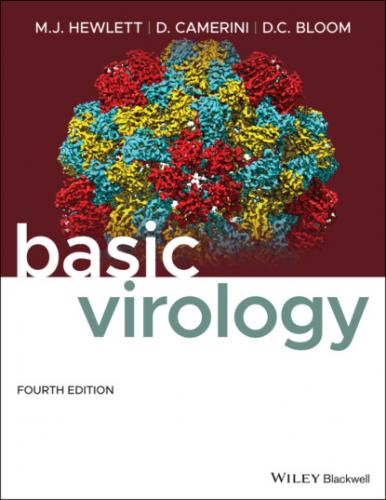Murine models
HSV infection in the eye or the footpad of mice can lead to a localized infection with spread of virus to the CNS and then to the brain. Although some animals die, as shown in Figure 3.6, survivors maintain a latent infection in sensory nerve ganglia. During this latent infection, no infectious virus can be recovered from nerve tissue, but if the nerve ganglia are explanted (dissected, dissociated, and maintained on a feeder layer of cultured cells), virus will eventually appear and begin to replicate. This observation demonstrates both that the viral genome is intact in the latently infected neuron, and that virus is not present in infectious form until something else occurs.
This model is quite useful for the study of genetic and other parameters during establishment and maintenance of a latent infection. For example, the sensory neurons can be isolated and viral DNA can be recovered. But since mice do not efficiently reactivate HSV, the physiological process of reactivation, where virus can be recovered at the site of initial infection, cannot be effectively studied in mice.
Rabbit models
Infection of rabbit eyes with HSV leads to localized infection and recovery. The rabbits maintain virus in their trigeminal ganglia, and viral DNA, virus, or both can be recovered using methods described for the murine model. Unlike mice, rabbits spontaneously reactivate HSV, and virus occasionally can be recovered from the rabbit's tear film. Further, this reactivation can be induced by iontophoresis of epinephrine with high frequency. Rabbits, because HSV can reactivate in them, are vital to the design of experiments to investigate induced reactivation, although they are more expensive to purchase and keep than mice.
Figure 3.6 Analysis of the establishment and maintenance of latent HSV infections in mice. A number of mice are inoculated in the footpad, and following the symptoms of primary disease, which include foot swelling and minor hindquarter paralysis, many mice recover. Those that do not recover have infectious virus in their CNS. The mice that recover are latently infected and no infectious virus can be detected, even with high‐sensitivity measurements of nervous and other tissue. HSV genomes, but not infectious virus, can be detected in nuclei of sensory nerve dorsal root ganglia. When these ganglia are cultured with other cells that serve both as an indicator of virus replication and as a feeder layer for the neurons (i.e., explanted), a significant number demonstrate evidence of virus infection and infectious virus can be recovered, as shown on the inset graph (two separate experiments are shown, with essentially the same results).
Guinea pig models
Guinea pigs are favored experimental animals for the study of infection and disease because they are readily infected with many human pathogens. They are an important model for the study of HSV‐2, which cannot be studied effectively in the murine and rabbit models just described.
Guinea pigs can be infected vaginally with inoculation of virus, and following a localized infection, latency can be established. As occurs in the murine and rabbit models, virus or viral DNA can be recovered from latently infected neurons (those enervating the vaginal area in this case). As in rabbits, latent infection in guinea pigs will spontaneously reactivate, and periodic examination can be used to measure reactivation rates. Unlike rabbits, however, guinea pig reactivation cannot be induced. Also, HSV‐2 reactivates much more frequently than does HSV‐1 in the guinea pig model; therefore, this model may be of some value in establishing the subtle genetic differences between these two types of viruses that manifest as a differential tropism for mucosa.
QUESTIONS FOR CHAPTER 3
1 In the case of rabies virus, how would you classify humans with respect to their role as a host?
2 What characteristics are shared by all hepatitis viruses?
3 Using the data presented in Table 3.1, answer the following questions:Which of the viruses in the table are vectored by mosquitoes?Which of the viruses in the table are transmitted in an aerosol?Which of the viruses in the table are transmitted by injection of blood?Which of the viruses in the table are neurotropic?
4 You are a viral epidemiologist studying the population of Spitzbergen Island off the coast of Norway (see Figure 3.2). Suppose that a team of scientists plans to visit this island by special boat during the Christmas holiday season. How might this visit change the pattern of respiratory infections you have been observing? What criteria must exist for this visit to have an effect on the pattern of viral respiratory illness on the island?
5 You have isolated two mutant strains of virus Z – mutant 1 and mutant 2. Neither strain can replicate when infected into cells, but either can be propagated in cell culture when coinfected with mutant virus 3. When you coinfect cultured cells with mutants 1 and 2 together, infection proceeds, but only mutant 1 and mutant 2 can be recovered from the infected cells. What is the best explanation of these results?
CHAPTER 4 Patterns of Some Viral Diseases of Humans
THE DYNAMICS OF HUMAN–VIRUS INTERACTIONS
Classification of human disease–causing viruses according to virus–host dynamics Viral diseases leading to persistence of the virus in the host are generally associated with viruses having long associations with human populations Viral diseases associated with acute, severe infection are suggestive of zoonoses
PATTERNS OF SPECIFIC VIRAL DISEASES OF HUMANS
Acute infections followed by virus clearing Colds and respiratory infections Influenza Variola
Infection of an “accidental” target tissue leading to permanent damage despite efficient clearing
Persistent viral infections
Papilloma and polyomavirus infections
Herpesvirus infections and latency
Other complications arising from persistent
